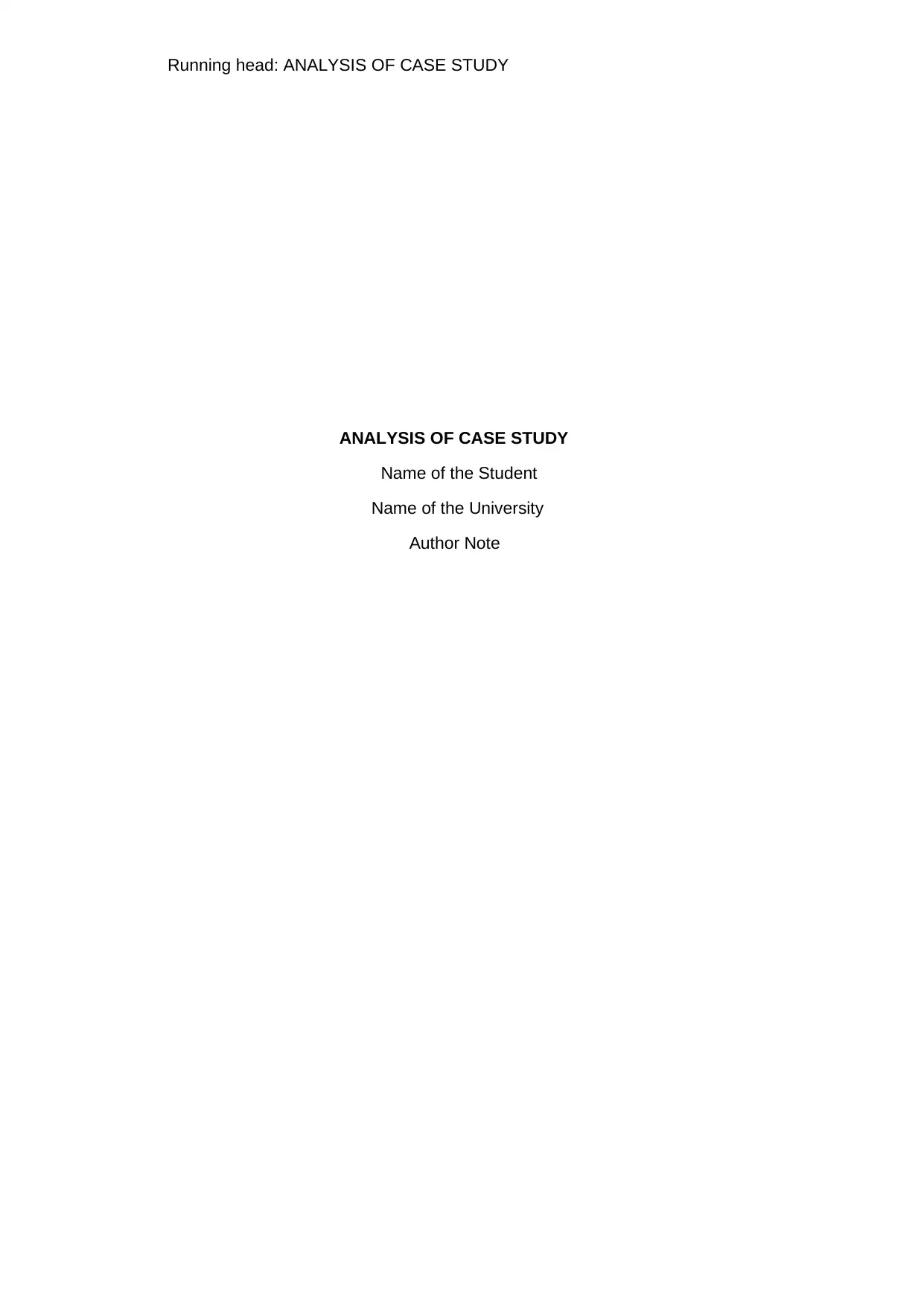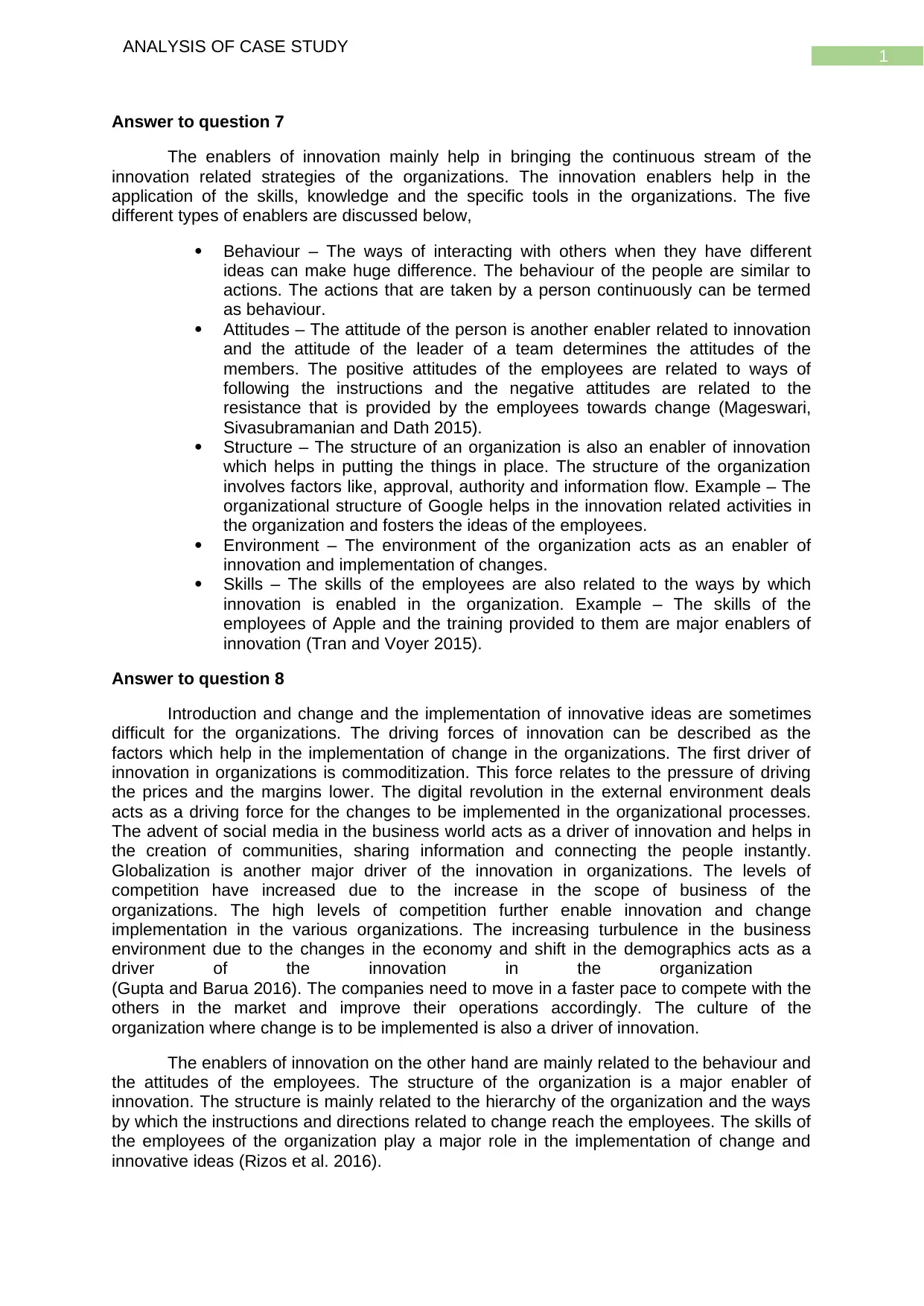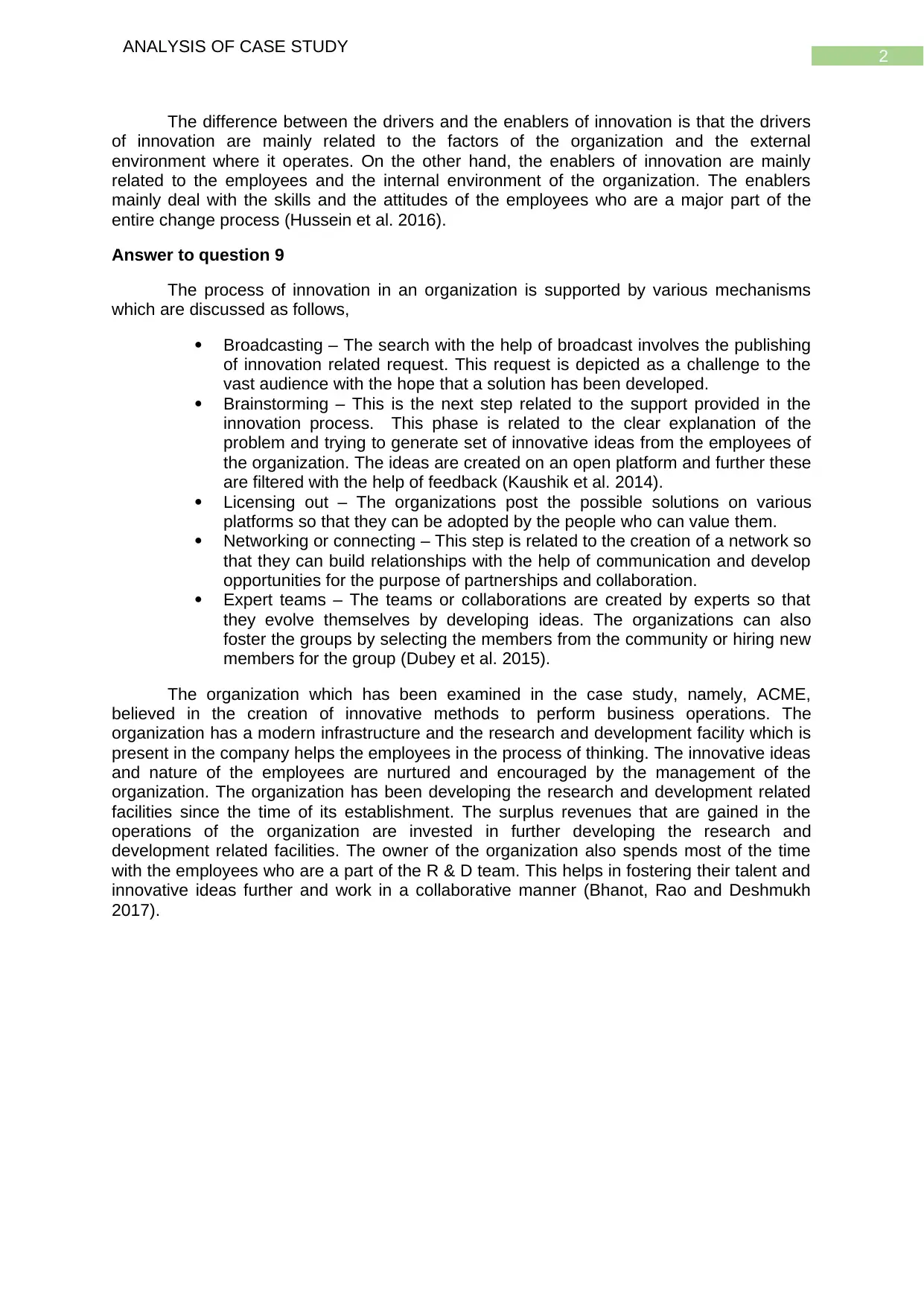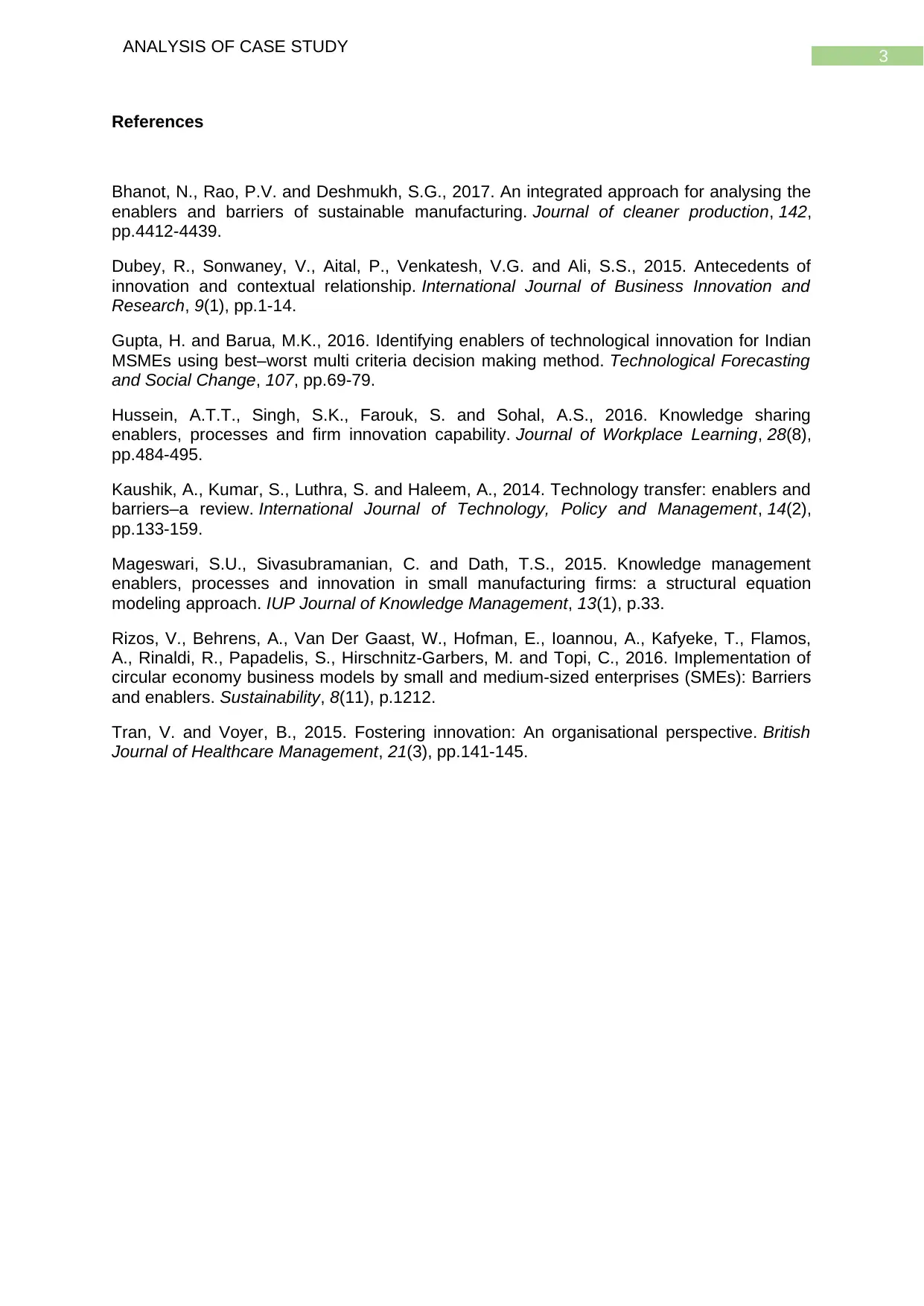Detailed Analysis of a Business Case Study: Innovation Strategies
VerifiedAdded on 2021/04/21
|4
|1503
|31
Case Study
AI Summary
This assignment provides an in-depth analysis of a business case study, specifically focusing on the drivers and enablers of innovation within an organization. The analysis examines how factors like commoditization, globalization, and technological advancements act as drivers, while employee behavior, attitudes, organizational structure, skills, and environment serve as enablers. The study explores the differences between drivers and enablers, highlighting that drivers are external and internal organizational forces, and enablers are employee-centric. The assignment also discusses various mechanisms that support the innovation process, such as broadcasting, brainstorming, networking, licensing out, and expert teams. The case study of ACME is used to illustrate these concepts, showcasing how the company fosters innovation through modern infrastructure, R&D facilities, and a collaborative work environment. The analysis references relevant literature to support its arguments, providing a comprehensive understanding of innovation management.

Running head: ANALYSIS OF CASE STUDY
ANALYSIS OF CASE STUDY
Name of the Student
Name of the University
Author Note
ANALYSIS OF CASE STUDY
Name of the Student
Name of the University
Author Note
Paraphrase This Document
Need a fresh take? Get an instant paraphrase of this document with our AI Paraphraser

1
ANALYSIS OF CASE STUDY
Answer to question 7
The enablers of innovation mainly help in bringing the continuous stream of the
innovation related strategies of the organizations. The innovation enablers help in the
application of the skills, knowledge and the specific tools in the organizations. The five
different types of enablers are discussed below,
Behaviour – The ways of interacting with others when they have different
ideas can make huge difference. The behaviour of the people are similar to
actions. The actions that are taken by a person continuously can be termed
as behaviour.
Attitudes – The attitude of the person is another enabler related to innovation
and the attitude of the leader of a team determines the attitudes of the
members. The positive attitudes of the employees are related to ways of
following the instructions and the negative attitudes are related to the
resistance that is provided by the employees towards change (Mageswari,
Sivasubramanian and Dath 2015).
Structure – The structure of an organization is also an enabler of innovation
which helps in putting the things in place. The structure of the organization
involves factors like, approval, authority and information flow. Example – The
organizational structure of Google helps in the innovation related activities in
the organization and fosters the ideas of the employees.
Environment – The environment of the organization acts as an enabler of
innovation and implementation of changes.
Skills – The skills of the employees are also related to the ways by which
innovation is enabled in the organization. Example – The skills of the
employees of Apple and the training provided to them are major enablers of
innovation (Tran and Voyer 2015).
Answer to question 8
Introduction and change and the implementation of innovative ideas are sometimes
difficult for the organizations. The driving forces of innovation can be described as the
factors which help in the implementation of change in the organizations. The first driver of
innovation in organizations is commoditization. This force relates to the pressure of driving
the prices and the margins lower. The digital revolution in the external environment deals
acts as a driving force for the changes to be implemented in the organizational processes.
The advent of social media in the business world acts as a driver of innovation and helps in
the creation of communities, sharing information and connecting the people instantly.
Globalization is another major driver of the innovation in organizations. The levels of
competition have increased due to the increase in the scope of business of the
organizations. The high levels of competition further enable innovation and change
implementation in the various organizations. The increasing turbulence in the business
environment due to the changes in the economy and shift in the demographics acts as a
driver of the innovation in the organization
(Gupta and Barua 2016). The companies need to move in a faster pace to compete with the
others in the market and improve their operations accordingly. The culture of the
organization where change is to be implemented is also a driver of innovation.
The enablers of innovation on the other hand are mainly related to the behaviour and
the attitudes of the employees. The structure of the organization is a major enabler of
innovation. The structure is mainly related to the hierarchy of the organization and the ways
by which the instructions and directions related to change reach the employees. The skills of
the employees of the organization play a major role in the implementation of change and
innovative ideas (Rizos et al. 2016).
ANALYSIS OF CASE STUDY
Answer to question 7
The enablers of innovation mainly help in bringing the continuous stream of the
innovation related strategies of the organizations. The innovation enablers help in the
application of the skills, knowledge and the specific tools in the organizations. The five
different types of enablers are discussed below,
Behaviour – The ways of interacting with others when they have different
ideas can make huge difference. The behaviour of the people are similar to
actions. The actions that are taken by a person continuously can be termed
as behaviour.
Attitudes – The attitude of the person is another enabler related to innovation
and the attitude of the leader of a team determines the attitudes of the
members. The positive attitudes of the employees are related to ways of
following the instructions and the negative attitudes are related to the
resistance that is provided by the employees towards change (Mageswari,
Sivasubramanian and Dath 2015).
Structure – The structure of an organization is also an enabler of innovation
which helps in putting the things in place. The structure of the organization
involves factors like, approval, authority and information flow. Example – The
organizational structure of Google helps in the innovation related activities in
the organization and fosters the ideas of the employees.
Environment – The environment of the organization acts as an enabler of
innovation and implementation of changes.
Skills – The skills of the employees are also related to the ways by which
innovation is enabled in the organization. Example – The skills of the
employees of Apple and the training provided to them are major enablers of
innovation (Tran and Voyer 2015).
Answer to question 8
Introduction and change and the implementation of innovative ideas are sometimes
difficult for the organizations. The driving forces of innovation can be described as the
factors which help in the implementation of change in the organizations. The first driver of
innovation in organizations is commoditization. This force relates to the pressure of driving
the prices and the margins lower. The digital revolution in the external environment deals
acts as a driving force for the changes to be implemented in the organizational processes.
The advent of social media in the business world acts as a driver of innovation and helps in
the creation of communities, sharing information and connecting the people instantly.
Globalization is another major driver of the innovation in organizations. The levels of
competition have increased due to the increase in the scope of business of the
organizations. The high levels of competition further enable innovation and change
implementation in the various organizations. The increasing turbulence in the business
environment due to the changes in the economy and shift in the demographics acts as a
driver of the innovation in the organization
(Gupta and Barua 2016). The companies need to move in a faster pace to compete with the
others in the market and improve their operations accordingly. The culture of the
organization where change is to be implemented is also a driver of innovation.
The enablers of innovation on the other hand are mainly related to the behaviour and
the attitudes of the employees. The structure of the organization is a major enabler of
innovation. The structure is mainly related to the hierarchy of the organization and the ways
by which the instructions and directions related to change reach the employees. The skills of
the employees of the organization play a major role in the implementation of change and
innovative ideas (Rizos et al. 2016).

2
ANALYSIS OF CASE STUDY
The difference between the drivers and the enablers of innovation is that the drivers
of innovation are mainly related to the factors of the organization and the external
environment where it operates. On the other hand, the enablers of innovation are mainly
related to the employees and the internal environment of the organization. The enablers
mainly deal with the skills and the attitudes of the employees who are a major part of the
entire change process (Hussein et al. 2016).
Answer to question 9
The process of innovation in an organization is supported by various mechanisms
which are discussed as follows,
Broadcasting – The search with the help of broadcast involves the publishing
of innovation related request. This request is depicted as a challenge to the
vast audience with the hope that a solution has been developed.
Brainstorming – This is the next step related to the support provided in the
innovation process. This phase is related to the clear explanation of the
problem and trying to generate set of innovative ideas from the employees of
the organization. The ideas are created on an open platform and further these
are filtered with the help of feedback (Kaushik et al. 2014).
Licensing out – The organizations post the possible solutions on various
platforms so that they can be adopted by the people who can value them.
Networking or connecting – This step is related to the creation of a network so
that they can build relationships with the help of communication and develop
opportunities for the purpose of partnerships and collaboration.
Expert teams – The teams or collaborations are created by experts so that
they evolve themselves by developing ideas. The organizations can also
foster the groups by selecting the members from the community or hiring new
members for the group (Dubey et al. 2015).
The organization which has been examined in the case study, namely, ACME,
believed in the creation of innovative methods to perform business operations. The
organization has a modern infrastructure and the research and development facility which is
present in the company helps the employees in the process of thinking. The innovative ideas
and nature of the employees are nurtured and encouraged by the management of the
organization. The organization has been developing the research and development related
facilities since the time of its establishment. The surplus revenues that are gained in the
operations of the organization are invested in further developing the research and
development related facilities. The owner of the organization also spends most of the time
with the employees who are a part of the R & D team. This helps in fostering their talent and
innovative ideas further and work in a collaborative manner (Bhanot, Rao and Deshmukh
2017).
ANALYSIS OF CASE STUDY
The difference between the drivers and the enablers of innovation is that the drivers
of innovation are mainly related to the factors of the organization and the external
environment where it operates. On the other hand, the enablers of innovation are mainly
related to the employees and the internal environment of the organization. The enablers
mainly deal with the skills and the attitudes of the employees who are a major part of the
entire change process (Hussein et al. 2016).
Answer to question 9
The process of innovation in an organization is supported by various mechanisms
which are discussed as follows,
Broadcasting – The search with the help of broadcast involves the publishing
of innovation related request. This request is depicted as a challenge to the
vast audience with the hope that a solution has been developed.
Brainstorming – This is the next step related to the support provided in the
innovation process. This phase is related to the clear explanation of the
problem and trying to generate set of innovative ideas from the employees of
the organization. The ideas are created on an open platform and further these
are filtered with the help of feedback (Kaushik et al. 2014).
Licensing out – The organizations post the possible solutions on various
platforms so that they can be adopted by the people who can value them.
Networking or connecting – This step is related to the creation of a network so
that they can build relationships with the help of communication and develop
opportunities for the purpose of partnerships and collaboration.
Expert teams – The teams or collaborations are created by experts so that
they evolve themselves by developing ideas. The organizations can also
foster the groups by selecting the members from the community or hiring new
members for the group (Dubey et al. 2015).
The organization which has been examined in the case study, namely, ACME,
believed in the creation of innovative methods to perform business operations. The
organization has a modern infrastructure and the research and development facility which is
present in the company helps the employees in the process of thinking. The innovative ideas
and nature of the employees are nurtured and encouraged by the management of the
organization. The organization has been developing the research and development related
facilities since the time of its establishment. The surplus revenues that are gained in the
operations of the organization are invested in further developing the research and
development related facilities. The owner of the organization also spends most of the time
with the employees who are a part of the R & D team. This helps in fostering their talent and
innovative ideas further and work in a collaborative manner (Bhanot, Rao and Deshmukh
2017).
⊘ This is a preview!⊘
Do you want full access?
Subscribe today to unlock all pages.

Trusted by 1+ million students worldwide

3
ANALYSIS OF CASE STUDY
References
Bhanot, N., Rao, P.V. and Deshmukh, S.G., 2017. An integrated approach for analysing the
enablers and barriers of sustainable manufacturing. Journal of cleaner production, 142,
pp.4412-4439.
Dubey, R., Sonwaney, V., Aital, P., Venkatesh, V.G. and Ali, S.S., 2015. Antecedents of
innovation and contextual relationship. International Journal of Business Innovation and
Research, 9(1), pp.1-14.
Gupta, H. and Barua, M.K., 2016. Identifying enablers of technological innovation for Indian
MSMEs using best–worst multi criteria decision making method. Technological Forecasting
and Social Change, 107, pp.69-79.
Hussein, A.T.T., Singh, S.K., Farouk, S. and Sohal, A.S., 2016. Knowledge sharing
enablers, processes and firm innovation capability. Journal of Workplace Learning, 28(8),
pp.484-495.
Kaushik, A., Kumar, S., Luthra, S. and Haleem, A., 2014. Technology transfer: enablers and
barriers–a review. International Journal of Technology, Policy and Management, 14(2),
pp.133-159.
Mageswari, S.U., Sivasubramanian, C. and Dath, T.S., 2015. Knowledge management
enablers, processes and innovation in small manufacturing firms: a structural equation
modeling approach. IUP Journal of Knowledge Management, 13(1), p.33.
Rizos, V., Behrens, A., Van Der Gaast, W., Hofman, E., Ioannou, A., Kafyeke, T., Flamos,
A., Rinaldi, R., Papadelis, S., Hirschnitz-Garbers, M. and Topi, C., 2016. Implementation of
circular economy business models by small and medium-sized enterprises (SMEs): Barriers
and enablers. Sustainability, 8(11), p.1212.
Tran, V. and Voyer, B., 2015. Fostering innovation: An organisational perspective. British
Journal of Healthcare Management, 21(3), pp.141-145.
ANALYSIS OF CASE STUDY
References
Bhanot, N., Rao, P.V. and Deshmukh, S.G., 2017. An integrated approach for analysing the
enablers and barriers of sustainable manufacturing. Journal of cleaner production, 142,
pp.4412-4439.
Dubey, R., Sonwaney, V., Aital, P., Venkatesh, V.G. and Ali, S.S., 2015. Antecedents of
innovation and contextual relationship. International Journal of Business Innovation and
Research, 9(1), pp.1-14.
Gupta, H. and Barua, M.K., 2016. Identifying enablers of technological innovation for Indian
MSMEs using best–worst multi criteria decision making method. Technological Forecasting
and Social Change, 107, pp.69-79.
Hussein, A.T.T., Singh, S.K., Farouk, S. and Sohal, A.S., 2016. Knowledge sharing
enablers, processes and firm innovation capability. Journal of Workplace Learning, 28(8),
pp.484-495.
Kaushik, A., Kumar, S., Luthra, S. and Haleem, A., 2014. Technology transfer: enablers and
barriers–a review. International Journal of Technology, Policy and Management, 14(2),
pp.133-159.
Mageswari, S.U., Sivasubramanian, C. and Dath, T.S., 2015. Knowledge management
enablers, processes and innovation in small manufacturing firms: a structural equation
modeling approach. IUP Journal of Knowledge Management, 13(1), p.33.
Rizos, V., Behrens, A., Van Der Gaast, W., Hofman, E., Ioannou, A., Kafyeke, T., Flamos,
A., Rinaldi, R., Papadelis, S., Hirschnitz-Garbers, M. and Topi, C., 2016. Implementation of
circular economy business models by small and medium-sized enterprises (SMEs): Barriers
and enablers. Sustainability, 8(11), p.1212.
Tran, V. and Voyer, B., 2015. Fostering innovation: An organisational perspective. British
Journal of Healthcare Management, 21(3), pp.141-145.
1 out of 4
Related Documents
Your All-in-One AI-Powered Toolkit for Academic Success.
+13062052269
info@desklib.com
Available 24*7 on WhatsApp / Email
![[object Object]](/_next/static/media/star-bottom.7253800d.svg)
Unlock your academic potential
Copyright © 2020–2025 A2Z Services. All Rights Reserved. Developed and managed by ZUCOL.



